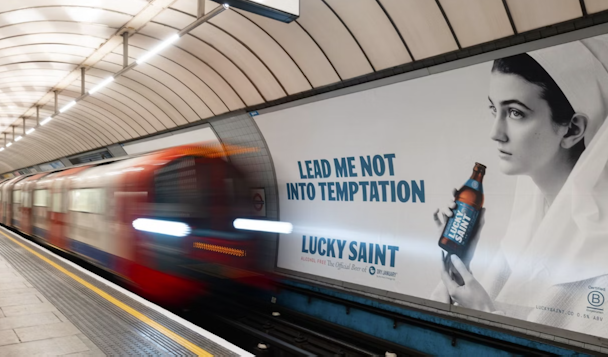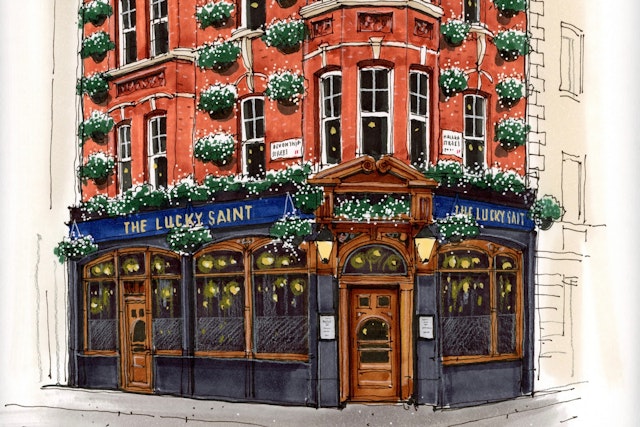This alcohol-free beer brand wants to make it Dry January all year round
Lucky Saint, a religious-themed alcohol-free beer, had a good Dry January. It credits a compelling out-of-home campaign showing nuns giving in to temptation.

Lucky Saint out of home ads on London's underground / Lucky Saint
Kerttu Inkeroinen, marketing and e-commerce director at Lucky Saint, tells The Drum that the Dry January billboards, featuring supposedly temperate nuns indulging in a godly beer, helped boost sales by 82% year-on-year, making it the fourth biggest contributor to the non-alcohol beer category in the UK.
Inkeroinen explains how the campaign performed.
The campaign reached seven million people 24 times on average. That rocketed brand awareness, more than doubling it comparing the end of January 2022 results to the end of January 2023. Lucky Saint also saw consideration grow by 86% between the period of the end November 2022 to the end of January 2023. Some 30% of people quizzed by the brand said they discovered the drink due to the January out-of-home campaign.
Advertisement
Inkeroinen is inclined to believe that the creative drove these impressive results. “We took the route of emotional brand building creative and messaging rather than only talking about the taste, the 0% alcohol or how many calories, which is what lot of the competition did at the time,” she says.
The ads were initially conceived as a brand awareness campaign, so Inkeroinen was surprised they boosted consideration so much. She said this validates her thinking that emotional creative can shift consumer behavior in the short term.
“It was obviously a big jump in our awareness and visibility and we had a lot of new people discover us for the first time. It helped us break through in a bigger consumer group,” Inkeroinen says.
‘Dry June’
In June, UK supermarket Tesco said that sales of no or low-alcohol beer were 25% higher in June than in January. Tesco’s beer buyer Jess Edmondson told the press: “The current boom is down to the number of authentic-tasting products now available from brewers who are using high-quality ingredients and more advanced methods.”
Advertisement
Lucky Saint’s sales matched this trend. While moderation has been slowly gaining momentum year-round, ‘dry June’ (as it’s being coined) is a clear marker that consumers have radically changed drink habits away from month-long alcohol purges.
-
The rise of alcohol-free: how to reach millennials and Gen Z changing the drinks industry
-
Why the ‘sober-curious’ will spur zero-alcohol sales well beyond Dry January
“It’s no longer once a month per year that people are thinking about when moderating; it’s now becoming part of the lifestyle,” Inkeroinen says.
This shift is influencing her marketing and media plans for 2024, which she is currently mapping out. “We believe that January’s still a great category moment, but we now have more than that one month that we can be active in,” Inkeroinen says. “Next year, more so in the past, we will be looking at yearlong activations.”
Tapping into fitness culture
Inkeroinen’s marketing strategy is to take advantage of places and spaces traditional beer brands can’t. This notion feeds into Lucky Saint’s activations and partnerships with fitness brands and events. In the summer of 2023, Lucky Saint is doing sampling at races like the Hackney half marathon, the Brighton Marathon and the Asics 10k in London.
“We strongly believe that the greatest reward of drinking is the social connection, not the alcohol. It’s for the moments when you can celebrate with people,” Inkeroinen says. It wouldn’t necessarily be appropriate after running a marathon to celebrate with friends and family by drinking alcohol, but it would be to drink Lucky Saint, Inkeroinen explains.
Suggested newsletters for you
“We’ve got a mantra that we use in our marketing which is to break rules but honor traditions,” she says. Inkeroinen says this means honoring the traditions of the beer category in the quality, process and ingredients while being able to “break the rules a bit” without the constraints of being an alcoholic product.
The Lucky Saint pub

Lucky Saint recently restored an iconic Marylebone pub that had shut down due to the pandemic. It reopened to the public serving both alcohol and non-alcoholic drinks. Inkeroinen says the initial idea for a pub came out of a need to find new offices and thinking, “As a beer brand, what’s more natural than working from a pub?”
On the consumer side, the Lucky Saint pub is trying to be a community hub by partnering with “like-minded brands and creating social connections for consumers.” For example, the pub has been the base for cycles with Rapha and tied with the running app Strava as well as hosting gigs with Sofar Sounds.
The bar also doubles up as a “testbed for what the perfect moderator’s pub and offering could look like,” she says. The team is working up ideas for training staff, displaying menus, and curating food and drink. “We are no experts by any means, but we’ve got a great space to explore and trial different options and get feedback from consumers,” Inkeroinen says. “We are learning how to create the perfect space for the changing consumer landscape.”
Summarizing her strategy for Lucky Saint, Inkeroinen tells The Drum: “What we want to do as a brand is not to be the zero version, or lesser than, or the no compromise. We are really here to build a brand in its own right. So just be proudly lucky Saint, which happens to be alcohol-free but is desirable rather than the zero version of something.”

